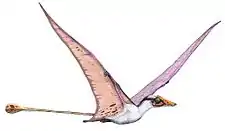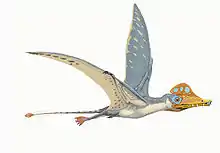Haopterus
Haopterus is a genus of pterodactyloid pterosaur from the Barremian-Aptian-age Lower Cretaceous Yixian Formation of Liaoning, China. Its fossil remains dated back 124.6 million years ago.
| Haopterus | |
|---|---|
 | |
| Holotype fossil specimen, Paleozoological Museum of China | |
| Scientific classification | |
| Kingdom: | Animalia |
| Phylum: | Chordata |
| Order: | †Pterosauria |
| Suborder: | †Pterodactyloidea |
| Clade: | †Lanceodontia |
| Clade: | †Istiodactyliformes |
| Clade: | †Mimodactylidae |
| Genus: | †Haopterus Wang & Lü, 2001 |
| Type species | |
| †Haopterus gracilis Wang & Lü, 2001 | |
Discovery and naming
It was in 2001 named by Wang Xiaolin and Lü Junchang. The type species is Haopterus gracilis. The genus name honors Professor Hao Yichun and combines his name with a Latinized Greek pteron, "wing". The specific name, "slender-built" in Latin, refers to the condition of the metatarsals.
The genus is based on holotype IVPP V11726, a crushed fossil found in 1998 at the Sihetun-locality. The layer it was discovered in, was argon-dated at an age of 124.6 million years. It was the first Chinese pterosaur fossil preserving the skull. It consists of the front half of a subadult, including a skull, lower jaws, pectoral girdle, sternum, wings, cervical and dorsal vertebrae, partial pelvis and metatarsals.
Description

The skull of Haopterus is with a length of 145 millimeters (5.7 in) long and low, lacking a crest. The snout is pointed but rounded. The maxilla and praemaxilla are completely fused with no visible suture. The nasopraeorbital skull opening is elongated and elliptical with a length of 4 centimeters (1.6 in), 27,6 percent of the total skull length. The lower jaws have a length of 128 millimeters (5.0 in). On the front two thirds of their length teeth are present. There are twelve pairs of teeth in both the upper and the lower jaws. The teeth are robust, sharp, pointed, and curving backwards. To the front they gradually increase in length and point more to the front. The first three pairs in the praemaxilla are very small though; the describers assumed these were replacement teeth, recently erupted.
The back of the skull and the cervical vertebrae are strongly crushed, obscuring most details. Eight dorsal vertebrae are preserved, with a total length of 52 millimeters (2.0 in). The sternum was fan-shaped with a prominent keel. The wings are robustly built; the ulna is with 101 millimeters (4.0 in) longer than the wing metacarpal which has a length of 89 millimeters (3.5 in). The wingspan of the type individual was estimated at 1.35 meter (4.43 ft). In comparison, the hindlimbs must have been weakly built, the metatarsal having a length of just 17 millimeters (0.67 in).
Phylogeny
Haopterus was by Wang classified as a member of the Pterodactylidae, mainly because of the combination of robust teeth with the lack of a skull crest. In 2006 however, a cladistic analysis by Lü showed it was a basal member of the Ornithocheiroidea sensu Unwin (2003).[1] Later, an analysis by Kellner et al., 2019 showed Haopterus to be a close relative of Mimodactylus. Together they form the family Mimodactylidae, which is the sister group to the Istiodactylidae.[2]
The cladogram below follows Witton's 2012 analysis:[3]
| ||||||||||||||||||||||||||||||||||||||||
The cladogram below is a topology recovered by Kellner et al. (2019). In the analyses, they recovered Haopterus as the sister taxon of Mimodactylus within the family Mimodactylidae, and placed within the more inclusive group Istiodactyliformes.[4]
| Istiodactyliformes |
| ||||||||||||||||||||||||||||||
Paleobiology
The authors concluded that its slender hindfeet meant that it was forced to move quadrupedally on land, suggesting a piscivore lifestyle as a specialised soarer.[5] Although it's close relative Mimodactylus was considered to be a faunivore feeding on crustaceans, suggested by Kellner et al., 2019.
References
- Lü Junchang; and Qiang Ji (2006), "Preliminary results of a phylogenetic analysis of the pterosaurs from western Liaoning and surrounding area", Journal of the Paleontological Society of Korea 22 (1): 239–261
- Kellner, Alexander W. A.; Caldwell, Michael W.; Holgado, Borja; Vecchia, Fabio M. Dalla; Nohra, Roy; Sayão, Juliana M.; Currie, Philip J. (2019-11-29). "First complete pterosaur from the Afro-Arabian continent: insight into pterodactyloid diversity". Scientific Reports. 9 (1): 1–9. doi:10.1038/s41598-019-54042-z. ISSN 2045-2322.
- Witton, Mark P. (2012). "New Insights into the Skull of Istiodactylus latidens (Ornithocheiroidea, Pterodactyloidea)". PLoS ONE. 7 (3): e33170. Bibcode:2012PLoSO...733170W. doi:10.1371/journal.pone.0033170. PMC 3310040. PMID 22470442.
- Kellner, Alexander W. A.; Caldwell, Michael W.; Holgado, Borja; Vecchia, Fabio M. Dalla; Nohra, Roy; Sayão, Juliana M.; Currie, Philip J. (2019). "First complete pterosaur from the Afro-Arabian continent: insight into pterodactyloid diversity". Scientific Reports. 9 (1). doi:10.1038/s41598-019-54042-z.
- Wang X. and Lü J. (2001). Discovery of a pterodactyloid pterosaur from the Yixian Formation of western Liaoning, China. Chinese Science Bulletin 45(12):447–454.
External links
- Haopterus in The Pterosauria













